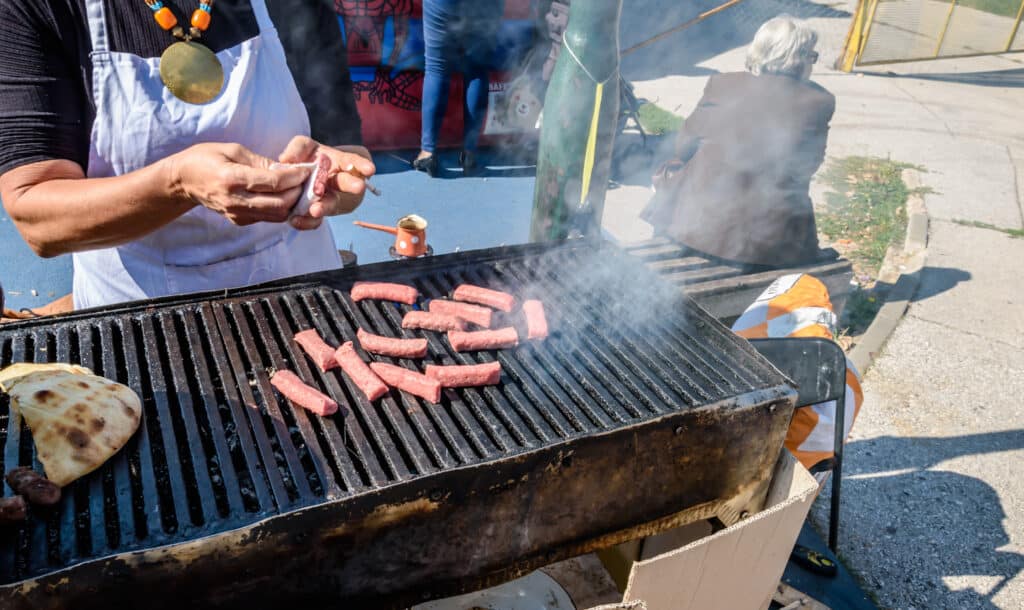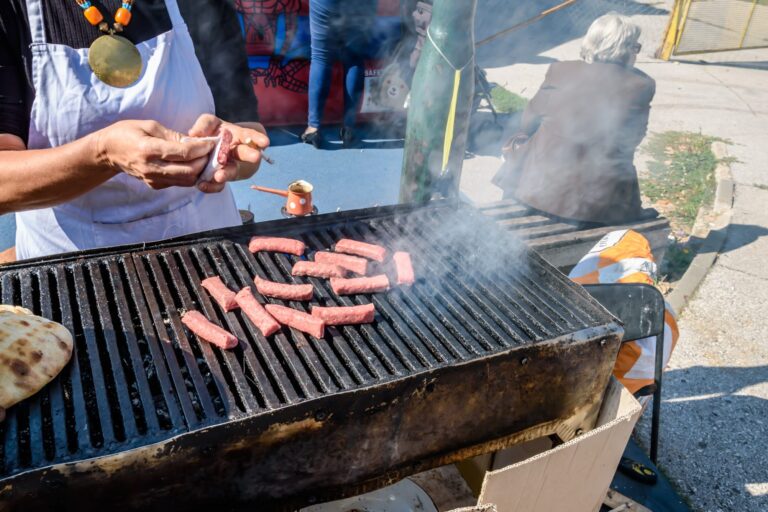Cevapi, the national dish of Bosnia Herzegovina, is a grilled sausage made from minced meat and served with Bosnian bread, onions, kajmak, and ajvar, with a rich history and cultural significance.
The origins of cevapi can be traced back to the Ottoman Empire, where it was introduced to the Balkans. Over time, it has become an integral part of Bosnian cuisine and is enjoyed by locals and visitors alike. The unique blend of spices and the smoky flavor from the grill make cevapi a rich meal.
Our team at Remitly created this guide to give you the full story on cevapi. Food is an integral part of every culture, and we love celebrating the traditional cuisines of our global customers. So, let’s dive in and uncover the fascinating world of cevapi.
The Origins of Cevapi: A Traditional Delight
Cevapi was introduced to the Balkans during the Ottoman rule and has since become an important part of regional cuisine from Bosnia to Serbia, Croatia, and beyond. The term “ćevapi” (singular: ćevap) is derived from the Arabic word “kebab,” influenced by Ottoman Turkish.
Originally, cevapi was made with ground beef, but over time, the recipe has evolved, and regional variations abound. Cevapi can be made with ground lamb, or even ground pork. The meat is typically seasoned with a blend of spices, including paprika, salt, pepper, and cumin.
Grilled to Perfection: The Art of Cooking Cevapi
Cevapi was traditionally made by hand, with the meat typically shaped into small, finger-sized portions before being cooked. and grilled over a charcoal fire.
Today, many Bosnians still prefer to prepare cevapi in this traditional way, as it provides the dish with a distinct smoky flavor.
To ensure that the cevapi is cooked to perfection, ithey allow the charcoal to burn down to a white-hot glow before placing the meat on the grill. The meat is cooked slowly over a low heat.
Once the cevapi is cooked through, it’s placed on a platter to rest for a few minutes. This allows the juices to redistribute throughout the meat, resulting in a more flavorful and tender dish.

The Perfect Blend: Exploring Cevapi’s Unique Spices
Cevapi owes much of its unique flavor to the combination of spices used in its preparation. Along with salt and pepper, the meat is typically seasoned with paprika, cumin, and sometimes a touch of garlic powder.
The paprika adds a subtle smokiness to the flavor, while the cumin provides a warm, earthy undertone. The garlic powder, if used, adds a pungent kick to the dish.
The proportions of these spices can vary depending on the cook’s preferences, but the blend typically results in a savory, aromatic flavor that sets cevapi apart from other grilled meats.
Meat Matters: The Trio of Lamb, Beef, and Pork
Cevapi is traditionally made with a combination of minced beef, lamb, and pork. Each type of meat contributes its own unique flavor and texture to the dish, resulting in a complex, multi-layered taste.
Beef provides a rich, meaty flavor, while lamb adds a slightly gamey undertone. Pork, on the other hand, contributes a rich, juicy quality to the meat. The combination of all three creates a flavor profile that is unmatched by any single type of meat.
The Aromatics: Garlic and Onions in Cevapi
In addition to the blend of spices used to season the meat, cevapi is often served with onions and garlic. These aromatics provide a sharp, pungent contrast to the savory meat, adding depth and complexity to the dish.
The onions are typically sliced thin and served raw, while the garlic may be either fresh or roasted. Both help to balance the richness of the meat and bring out its unique flavor profile.
Cevapi’s Sidekick: The Irresistible Flatbread
Cevapi is traditionally served with somun, a type of Bosnian flatbread similar to pita bread. The bread is typically soft and fluffy, with a slight tangy flavor that pairs with the savory meat.
Somun is often brushed with butter or oil before being grilled alongside the cevapi, which gives it a slightly crispy exterior and a soft, chewy interior.
Cevapi is typically served in restaurants, cafes, and street-side stalls across the country, and is a staple at festivals and other cultural events.
Recipe: Traditional Bosnian Cevapi
Ingredients:
- 500g minced beef
- 250g minced lamb
- 250g minced pork
- 1 teaspoon paprika
- 1 teaspoon salt
- 1/2 teaspoon black pepper
- 1/2 teaspoon cumin
- Optional: 1/2 teaspoon garlic powder
- 1 onion, finely chopped
- 2 cloves of garlic, minced
- Somun or pita bread, for serving
- Sliced onions, for serving
Instructions:
- In a large bowl, combine the ground meat, such as minced beef, lamb, and pork. Mix well to ensure the meats are evenly distributed.
- Add the paprika, salt, black pepper, cumin, and garlic powder (if using) to the meat mixture. Mix thoroughly to evenly distribute the spices.
- Cover the bowl with plastic wrap and refrigerate for at least 1 hour to allow the flavors to meld together.
- Preheat a charcoal grill to medium heat. Alternatively, you can use a stovetop grill pan or a regular frying pan.
- Take a small handful of the meat mixture and shape it into a small sausage shape, about the size of your finger. Repeat with the remaining meat mixture.
- Place the cevapi on the preheated grill and cook for about 5-7 minutes per side, or until they are browned and cooked through.
- While the cevapi are cooking, heat a small amount of olive oil in a frying pan over medium heat. Add the chopped onions and minced garlic and sauté until they are soft and translucent.
- Once the cevapi are cooked, remove them from the grill and let them rest for a few minutes.
- Serve the cevapi on somun or pita bread, topped with the sautéed onions and garlic. You can also serve them with raw onions.
Note: Cevapi can also be served with a side of ajvar, a roasted red pepper and eggplant spread, and kajmak, a creamy dairy product similar to clotted cream. Greek yogurt or sour cream can work as a substitute.
Baking Soda: A Controversial Ingredient
The use of baking soda in ćevapi recipes varies, but it’s not uncommon. Baking soda acts as a leavening agent that can make the meat more tender and juicy by altering the pH level. When included, it’s generally used in small quantities, and the meat mixture is often allowed to rest for a period of time to let the baking soda do its work before the ćevapi are formed and grilled.
However, purists might argue that traditional recipes do not include baking soda, relying instead on the quality of the meat and the skill of the cook.
A Balkan Favorite
Cevapi is more than just a dish; it is a symbol of Balkan culture and heritage. While it’s a beloved national dish in Bosnia and Herzegovina, it’s also a tradition in neighboring countries. Regional variations are numerous, and extend from Greece to Slovenia, Albania, Montenegro, Kosovo, Macedonia, and Bulgaria.
For instance, in Albania, a similar dish called “qebapa” exists, which is also a form of grilled minced meat. It’s often served with flatbread and sides like raw onions.
In Bulgaria, a similar dish is known as “kebapche,” which is a spiced, grilled minced meat sausage, typically served with a side of “shopska” salad, bread, and a yogurt-based sauce.
Whether you enjoy it at a local Bosnian restaurant or try your hand at making it at home, cevapi will give you a glimpse into the rich culinary traditions of southeastern Europe.
